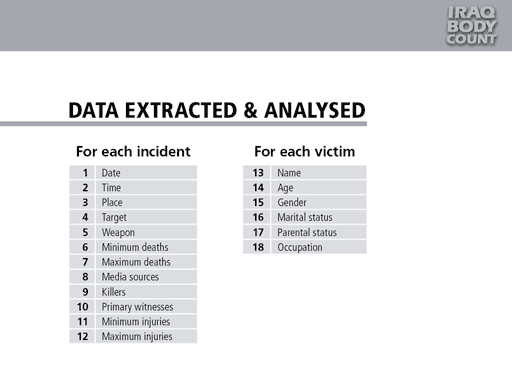In early 2006 IBC was invited to introduce its work at a Working Group Meeting on methods used by researchers to estimate armed conflict deaths (organised by the Small Arms Survey, Geneva, 17 Feb 2006).
Well-received by experts at the meeting, On Iraq Body Count summarised the project’s key features and innovations.
Data extracted and analysed
| For each incident | |
|---|---|
| 1 | Date |
| 2 | Time |
| 3 | Place |
| 4 | Target |
| 5 | Weapon |
| 6 | Minimum deaths |
| 7 | Maximum deaths |
| 8 | Media sources |
| 9 | Killers |
| 10 | Primary witnesses |
| 11 | Minimum injuries |
| 12 | Maximum injuries |
| For each victim | |
| 13 | Name |
| 14 | Age |
| 15 | Gender |
| 16 | Marital status |
| 17 | Parental status |
| 18 | Occupation |
2.0 Our sources and what we can extract from them.
Our surveillance of media is not passive but proactive. We gain our information from a variety of key-word searches of all English language press and media reports published on the web.
-
Active collection of media reports has to be done within days of the report appearing.
-
We should point out that subscription databases such as Lexis-Nexis contain nowhere near complete archives of these reports. Many stories quickly disappear from the web. The later you leave it to search the harder the stories are to find.
-
We require corroboration of any report of death from at least two sources meeting our basic criteria of professionalism.
-
We scan all press reports for evidence relevant to 18 different variables on which we extract and store information. These variables are shown in the slide above.
